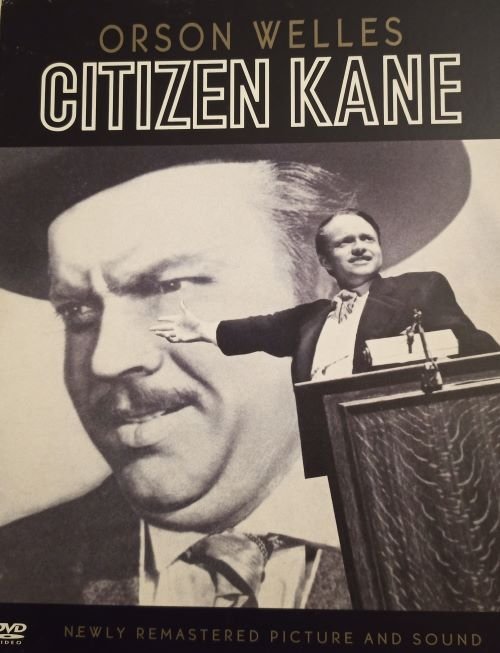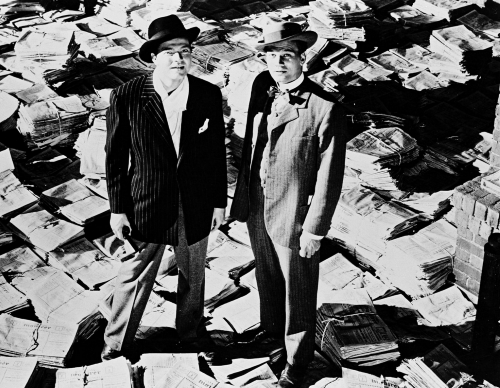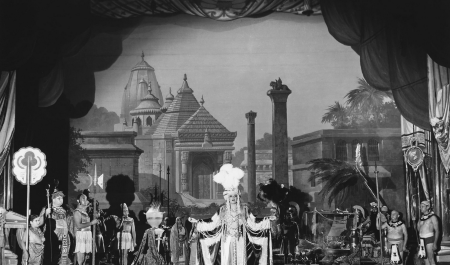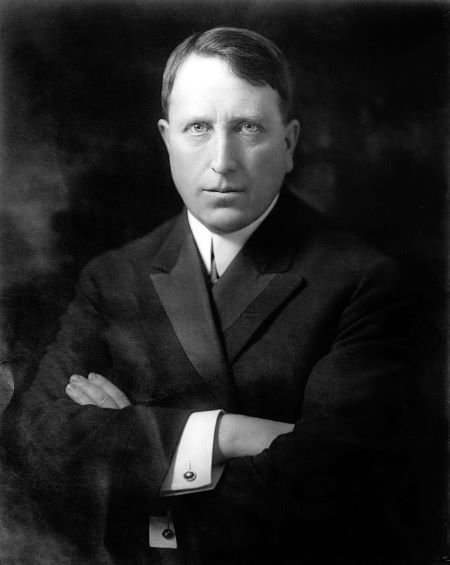Cine TV Contest #100: Citizen Kane is a Masterpiece for what it represents for the Seventh Art / Ciudadano Kane es una Obra Maestra por lo que representa para el Septimo Arte [English-Spanish] .

I always wanted to make a publication that relates to the film Citizen Kane, a film that when I saw it for the first time in the National Cinematheque of my country in the early 80's was very difficult to digest and I did not understand why it was listed as the best film in the world.
At that time I did not understand that for its release the script was innovative and complex, playing with the conventional narrative structure, parallel editing and other narrative resources rarely used at that time.
Flashback was used as a narrative device to tell the story of Charles Foster Kane, a newspaper magnate whose life is unraveled through the memories of different characters who knew him, creating an intriguing plot that tries to keep the viewer involved from beginning to end.
Citizen Kane is a film that has been widely praised and considered by many critics to be the greatest film of all time. However, it has also received criticism from those who do not share this opinion.
Directed and starring Orson Welles in 1941, the film introduced revolutionary techniques in cinematography, such as the use of unusual camera angles, play of light and shadow, and a non-linear narrative. These innovations have influenced the way films are made to this day.
This fragmented, non-linear narrative structure became a benchmark for modern cinema, influencing directors such as Quentin Tarantino and Christopher Nolan.
The film pioneered the use of depth of field, allowing several elements in the foreground and background to be in focus at the same time. This created a sense of realism and depth in the scenes, bringing a new visual dimension to cinema. In addition, Welles and his cinematographer Gregg Toland experimented with unusual camera angles and bold camera movements, such as long, complex sequence shots that required meticulous coordination and planning.
The scenes are carefully planned and shot, creating a visually stunning environment that complements the film's story. Some scenes stand out, such as the famous hall of mirrors scene and the opening sequence with the snowball, which have been praised for their originality and creativity.
Orson Welles and his team of collaborators created elaborate and detailed sets that contributed to the setting of the story. The use of models and special effects that were revolutionary for the time, such as the scene of Kane's mansion in flames, demonstrated the film's ability to surprise the viewer and transport him to another world.
The film's technical importance lies in its innovative storytelling, photography, lighting and production design, which broke with established conventions and laid the foundations for modern cinema. Orson Welles succeeded in creating a timeless work that continues to be studied and admired for its creative daring and lasting impact on the film industry.
Orson Welles masterfully plays the title character, Charles Foster Kane, displaying a wide range of emotions and nuances in his performance. Likewise, the rest of the cast also excels in their performances, adding to the depth of the film.
Joseph Cotten plays Jedediah Leland, the best friend and confidant of the protagonist, Charles Foster Kane. Leland is a complex and multifaceted character who plays a crucial role in the film's narrative. Cotten's performance conveys the loyalty and friendship Leland feels towards Kane, as well as his growing disillusionment and disenchantment with the media mogul.
His performance was considered one of the highlights of the film, and many consider his performance to have been instrumental in the success and resonance of Citizen Kane as a cinematic masterpiece.

Source
Dorothy Comingore, in the role of Susan Alexander Kane, has come under fire from some critics who find her performance somewhat stilted and unnatural. Despite this, others praise her ability to convey the naivety and vulnerability of her character.

However, despite all these qualities, Citizen Kane has also received criticism from those who do not consider it the best film in the world who say the film is pretentious and overly complicated, making it difficult for the general public to enjoy.
The film generated a controversy between William Randolph Hearts, (media mogul), and Orson Welles, (considered a creative genius in the world of cinema).
The film was inspired by the life of Hearts, he felt attacked by the obvious similarities between him and the character of Charles Foster Kane.

Hearts waged a campaign against the film , attempting to discredit it as well as Welles. He used his media to spread rumors and negative reviews about Welles and his work. However, the film became a masterpiece of cinema and a reference of world cinematography.
After so many years, I began to like the film Citizen Kane, because as a cinephile I finally managed to understand the complexity of the film. Its main character, Charles Foster Kane, his evolution from an idealistic young man to a bitter and lonely man. His excessive ambition and his quest for power lead him to make mistakes and alienate the people who love him most. This duality in his character makes him very human. The film is full of long, complex sequence shots, quick editing and creative use of lighting and perspective.
Another reason I enjoy Citizen Kane is the relevance of its message. Despite being made almost 84 years ago, the film still speaks to universal themes such as power, unbridled ambition and loneliness.
It is a film that has been widely praised for its innovation, (in its time), performances and cinematography. Despite the criticism it has received, it is still considered a cinematic masterpiece that has influenced generations of filmmakers. Ultimately, the film continues to generate debate and controversy, demonstrating its lasting impact on the film industry.
This is a must-see film for any self-respecting cinephile that believe me is gaining a lot with the passing of time, plus it is mandatory analysis in all film schools worldwide.

Congratulations to the CineTV community, which has already reached its 100th contest. It is a great achievement and we must celebrate it in style by participating in this initiative Link Here. You can see the great effort of its administrators and its moderator in offering film fans very diverse initiatives. It is an honor to belong to the community, heading towards the infinite edition of the contest 🤣.
Good luck to all the participants.
The first and last images are my property, and belong to my personal movie collection, they were taken with my Umidigi F2 cell phone.
The separator is free to use and was provided by @onexel. Link Here.

Siempre quise hacer una publicación que se relacione con la película Ciudadano Kane, un film que cuando lo vi por primera vez en la Cinemateca Nacional de mi país al principio de los años 80 me fue muy difícil de digerir y no comprendía el porque la catalogaban como la mejor película del mundo.
En aquella época no comprendía que para su estreno el guion resulto innovador y complejo, que juega con la estructura narrativa convencional , montaje paralelo y otros recursos narrativos poco utilizados entonces.
Se utilizo el flashback como recurso narrativo para contar la historia de Charles Foster Kane, un magnate de la prensa cuya vida es desentrañada a través de los recuerdos de diferentes personajes que lo conocieron, creando una trama intrigante que intenta mantener involucrado de principio a fin al espectador.
Ciudadano Kane es una película que ha sido ampliamente elogiada y considerada por muchos críticos como la mejor película de todos los tiempos. Sin embargo, también ha recibido críticas por parte de aquellos que no comparten esta opinión.
Fue dirigida y protagonizada por Orson Welles en 1941, la película introdujo técnicas revolucionarias en la cinematografía, como el uso de ángulos de la cámara inusuales, juegos de luces y sombras, y una narrativa no lineal. Estas innovaciones han influido en la forma en que se hacen las películas hasta el día de hoy.
Esta estructura narrativa fragmentada y no lineal se convirtió en un referente para el cine moderno, influyendo a directores como Quentin Tarantino y Christopher Nolan.
La película fue pionera en el uso de la profundidad de campo, permitiendo que varios elementos en primer y segundo plano estuvieran en foco al mismo tiempo. Esto creó una sensación de realismo y profundidad en las escenas, aportando una nueva dimensión visual al cine. Además, Welles y su director de fotografía Gregg Toland experimentaron con ángulos de cámara inusuales y movimientos de cámara audaces, como planos secuencia largos y complejos que requirieron un meticuloso trabajo de coordinación y planificación.
Las escenas están cuidadosamente planificadas y filmadas, creando un ambiente visualmente impactante que complementa la historia de la película. Destacan algunas escenas como la famosa escena del salon de los espejos y la secuencia inicial con la bola de nieve, que han sido elogiadas por su originalidad y creatividad.
Orson Welles y su equipo de colaboradores crearon escenarios elaborados y detallados que contribuyeron a la ambientación de la historia. El uso de maquetas y efectos especiales revolucionarios para la época, como la escena de la mansión de Kane en llamas, demostraron la capacidad de la película para sorprender al espectador y transportarlo a otro mundo.
La importancia técnica del film radica en su innovadora narrativa, fotografía, iluminación y diseño de producción, que rompieron con las convenciones establecidas y sentaron las bases para el cine moderno. Orson Welles logró crear una obra atemporal que sigue siendo estudiada y admirada por su audacia creativa y su impacto duradero en la industria cinematográfica.
Orson Welles interpreta magistralmente al personaje principal, Charles Foster Kane, mostrando una amplia gama de emociones y matices en su interpretación. Asimismo, el resto del elenco también se destaca por sus actuaciones, lo que contribuye a la profundidad de la película.
Joseph Cotten interpreta a Jedediah Leland, el mejor amigo y confidente del protagonista, Charles Foster Kane. Leland es un personaje complejo y multifacético que juega un papel crucial en la narrativa de la película. La interpretación de Cotten transmite la lealtad y la amistad que Leland siente hacia Kane, así como su creciente desilusión y desencanto con el magnate de los medios de comunicación.
Su interpretación fue considerada como uno de los puntos destacados de la película, y muchos consideran que su actuación fue fundamental para el éxito y la resonancia de Ciudadano Kane como una obra maestra del cine.

Fuente
Dorothy Comingore, en el papel de Susan Alexander Kane, ha sido objeto de críticas por parte de algunos críticos que consideran que su actuación resulta algo forzada y poco natural. A pesar de esto, otros elogian su capacidad para transmitir la ingenuidad y vulnerabilidad de su personaje.

Sin embargo, a pesar de todas estas cualidades, El Ciudadano Kane también ha recibido críticas por parte de aquellos que no la consideran la mejor película del mundo los cuales dicen el film es pretencioso y excesivamente complicado, lo que dificulta su disfrute por parte del público general.
El film genero una controversia entre William Randolph Hearts, ( magnate de los medios de comunicación), y Orson Welles ,(considerado un genio creativo en el mundo del cine).
La película se inspira en la vida de Hearts, este se sintió atacado por las similitudes evidentes entre él y el personaje de Charles Foster Kane.

Hearts emprendió una campaña en contra de la película , intentando desprestigiarla al igual que a Welles. Utilizó sus medios de comunicación para difundir rumores y críticas negativas sobre Welles y su obra. Sin embargo, la película se convirtió en una obra maestra del cine y en un referente de la cinematografía mundial.
Después de tantos años, la película Ciudadano Kane comenzo a gustarme, ya que como cinefilo por fin logre comprender la complejidad del film. Su personaje principal, Charles Foster Kane, su evolución desde un joven idealista hasta un hombre amargado y solitario. Su ambición desmedida y su búsqueda de poder que lo llevan a cometer errores y a alienar a las personas que más lo quieren. Esta dualidad en su personaje lo hace muy humano. La película está llena de planos secuencia largos y complejos, montajes rápidos y uso creativo de la iluminación y la perspectiva.
Otra razón por la que disfruto de Ciudadano Kane es la relevancia de su mensaje. A pesar de haber sido realizada hace casi 84 años, la película sigue hablando sobre temas universales como el poder, la ambición desmedida y la soledad.
Es una película que ha sido ampliamente elogiada por su innovación,(en su época), actuaciones y cinematografía. A pesar de las críticas que ha recibido, sigue siendo considerada una obra maestra del cine que ha influenciado a generaciones de cineastas. En última instancia, la película sigue generando debate y controversia, lo que demuestra su impacto duradero en la industria cinematográfica.
Este es un film indispensable para cualquier cinéfilo que se precie que créanme va ganando mucho con el pasar del tiempo, ademas es de análisis obligatorio en todas las escuelas de cine a nivel mundial.

Muchas felicitaciones a la comunidad CineTV, que ya llego a su concurso #100. Es un gran logro y hay que celebrarlo por todo lo alto participando en la presente iniciativa Link Aqui. Se nota el gran esfuerzo de sus administradores y su moderador en ofrecer a los fanaticos de cine iniciativas muy diversas. Es un honor pertenecer a la comunidad, rumbo a la edición infinita del concurso 🤣.
Suerte a todos los participantes.
La primera y la ultima imagen son de mi propiedad, y pertenecen a mi colección personal de películas, fueron tomadas con mi teléfono celular Umidigi F2.
El separador es de uso gratuito y fue proporcionado por @onexel. Link Aquí.
Saludos por acá. Cómo siempre una reseña muy agradable de leer. Me pasó lo mismo cuando la ví la primera vez, pues no lograba comprender esa majestuosidad de la que hablaban mis profesores y amantes del cine. Todo cobra sentido cuando nos ponemos en el contexto de la época y entendemos que las técnicas y recursos utilizados no fueron poca cosa. Cómo dices, es una cuestión de analizar y dar crédito a lo que se ve. Abrazos.
Hola, muchísimas gracias por comentar, es un film que innovo en la música, en la estructura y la narrativa de las películas en su época, con una mezcla de generos que aun descoloca a muchos espectadores. Innegable su aporte al séptimo arte.